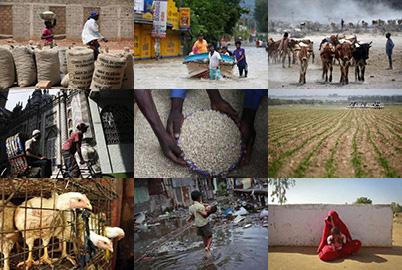Failure to adapt agriculture to climate shifts could cause catastrophic food shortages, World Resources Institute warns
By Megan Rowling
BARCELONA, June 23 (Thomson Reuters Foundation) - Farmers in Ethiopia are moving maize and teff fields to higher ground as temperatures rise, while in Bangladesh rice is being swapped for fish ponds in coastal areas where encroaching seas have turned water and soils salty.
Around the world, agriculture is adapting to accelerating climate change impacts as erratic weather and rising oceans make it harder for farmers to get by with existing crops and ways of working, researchers said on Wednesday.
Nearly a billion people live in countries that will struggle to manage the ecological changes they are expected to face by 2050 - and failure to act could cause catastrophic food shortages, they warned in a report from the World Resources Institute (WRI).
"Governments, funders, and researchers need to recognise that in climate hotspots, incremental adaptation measures, while essential, will be increasingly insufficient to avert loss and damage in farming and herding communities," Manish Bapna, acting WRI president, wrote in a foreword.
The report from the Washington-based think-tank said those areas would need wholesale changes to farming practices, rather than small adjustments, if they are to sustain local communities - a process described as "transformative adaptation".
The hotspots include semi-arid and desert regions in India and sub-Saharan Africa, coastal rice–growing areas in Bangladesh and Vietnam, and parts of Peru and the Himalayas where agriculture now relies on meltwater from glaciers and snow.
"There are some places where we are already seeing what is currently being grown or produced hitting tipping points - where it's just becoming harder and harder," said Rebecca Carter, deputy director of WRI's climate resilience practice.
But so far there has been little recognition that "in some cases there are just going to be limits to how far the current agricultural production systems can be adapted," she told the Thomson Reuters Foundation.
Carter, who comes from a family of ranchers in the U.S. state of Idaho, said she understood that making such changes would be tough because "what people produce is really central to their identity".
But, she added, it was time to start talking about the options farmers and those raising livestock have available, including growing different crops, breeding other animals or using new methods or equipment, such as poly-houses that keep off wild weather and save water to cultivate vegetables in India.
The report noted some farmers are already making big shifts on their own.
In northern India, for example, rising temperatures and a decline in the chilly days needed for apple cultivation have driven a switch to pomegranates in the Kullu Valley of Himachal Pradesh state.
And in Costa Rica, coffee producers are planting citrus trees that are better suited to hotter, drier conditions.
But it is easier for those with more land and better access to credit and information to make such changes, the report noted.
It pointed to the need to provide more funding and support to poorer people with fewer resources so they can have more choices, manage risks better and make decisions about their future under new climatic conditions.
CONSULTING COMMUNITIES
Teresa Anderson, climate policy coordinator for ActionAid International, which was not involved in the WRI report, said its focus on including vulnerable groups - such as women, youth and indigenous people - in efforts to plan transformative adaptation was important.
"If these processes fail to be inclusive from the start, the transitions may well only benefit the elites while actually harming marginalised communities more," she warned.
Shifting to different crops, locations or growing methods will require new knowledge, rural infrastructure and markets - and small-scale farmers, especially women, face extra barriers because they lack access to land and finance, she said.
Her organisation has worked with rural communities from Africa to Asia, consulting women and others who traditionally have no voice in decision-making, sometimes by using flip-charts or even making maps on the ground with leaves and sticks.
Anderson said she had seen how this grassroots approach could give women confidence to talk to policy makers about climate adaptation measures needed in their villages.
"It is important that any transformation addresses inequalities and doesn't exacerbate them," she said.
Read more:
Britain 'not prepared' for climate threats, from heat to food shortages
Leaders flag need to adapt to 'punishing reality' of hotter planet
Adaptation no longer 'Cinderella' of climate action - but barriers remain
(Reporting by Megan Rowling @meganrowling; editing by Laurie Goering. Please credit the Thomson Reuters Foundation, the charitable arm of Thomson Reuters, that covers the lives of people around the world who struggle to live freely or fairly. Visit http://news.trust.org/climate)
Our Standards: The Thomson Reuters Trust Principles.

